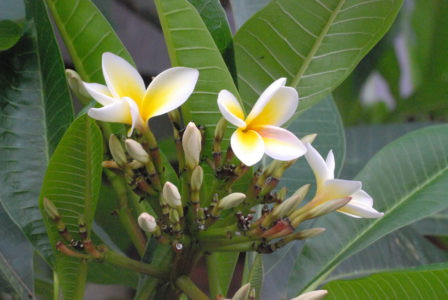Designing with Succulents

Plumeria plants provide a fragrant, attractive flower.
Debra Lee Baldwin frequently gives talks to garden clubs. Her most recent talk at the San Diego Horticultural Society gave highlights from her latest book, “Designing with Succulents.”
Probably the greatest motivation for planting succulents in San Diego County is fire protection. During the wildfires many people said, “Succulents saved our house.” Baldwin showed us photographs of gardens right after the fire. The homes with succulent gardens fared far better than the average house surrounded by English cottage gardens. Baldwin said, “Succulents cook, not burn.”
Another motivation for planting succulents is financial (not that protecting your house from fire isn’t also a financial benefit). Succulents use less water than do lawns and typical cottage garden plantings. This is an ecological benefit as well since we have a definite water issue on this planet. Succulents do not require heavy fertilizers and pesticides which also means they cause little pollution to our ground water.
For many years Baldwin has been teaching the world about the beauty of succulents. In her book and her talk, Baldwin showed the difference between a well-designed garden and one without design. She illustrated these differences using her own garden and others.’ Since Baldwin’s gardens include many container gardens, she also discussed pot and plant pairings. If you have a container you really love, try to find plants that reflect one or more elements of the pot’s design. Perhaps there is a hint of a color you really like. Look for a succulent that has that particular shade which will make that color stand out more in the pot. You also could duplicate its shape or line with the plant you choose. The plants should reflect aspects of their containers.
Baldwin also spoke about the tools she uses. She keeps a spray bottle filled with 70 percent Isotopic alcohol. She has a tweezer for “protection against vicious” plants. A steak knife is handy for dividing plants, and the push of a chopstick or pencil can create a hole for a tiny plant or root.
Baldwin advocates adhering to elements of good design and common sense. Repetition of shapes massed together gives the eye a resting place. These can be strung out to guide the eye to another point creating a sense of motion. Contrast is another element of design that is important. Even the contrast between older and newer leaves adds interest to the design. Leaf shapes, overall plant shape, and color can augment both repetition and contrast. Barrel cactus make nice contrast to tall aloe reno folium. The spears look striking against a background of pudgy barrel cactus.
Boulders, rocks, and gravel are other elements that can help create your design. However, Baldwin has a few words of caution. Creek beds (faux creek beds) are never above the ground. They would be found in gullies, and that’s where they belong in your garden. You can create your own.
Another factor to consider is the size or the multiplication factor. Century plants “multiply like rabbits,” says Baldwin. They are hard to dig out. Know your plant’s propagation pattern and also its rate of growth. You should be aware that euphorbia and many other plants have a toxic sap. Ornamental grasses may be hard to control. Most succulents fare well with maintenance from two to four times a year. If you go on line, Baldwin has videos about everything from fertilizing to propagating. She does caution against using commercial fertilizers. If you use them, dilute them to half strength. Personally, I have more and more succulents; they look great and have yet to be fertilized or bug sprayed.
Because succulents are easy to grow, exchanging cuttings is common. This leads to another benefit of planting succulents: friendship. Whenever you see a plant that has grown from a friend’s cutting, you think of that person. I have cuttings from friends whom I always remember when I look at the plant. Dick Disraeli gave me some cuttings when he pruned his plumeria a few years ago. I now have a magnificent array of plumeria, both pink and yellow, in a pot in my front yard. I think of him every time I approach my house or go out my front door. I have euphorbia in various locations, each from a different person whom I remember when I see the plants.
Baldwin’s talks are always interesting, and her photographs are outstanding. I have grown to like succulents from necessity; but if you’ll pardon the pun, they do grow on you. Our next meeting will feature a demonstration of rose and fruit tree pruning at the Mission Hills Nursery, 1525 Fort Stockton, on Wednesday, January 24 from 6 to 8 p.m. Members are free, and guests pay $10.
Category: Education, Local News







